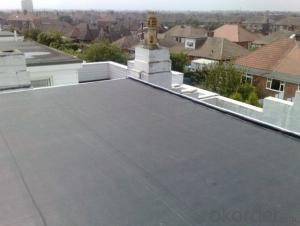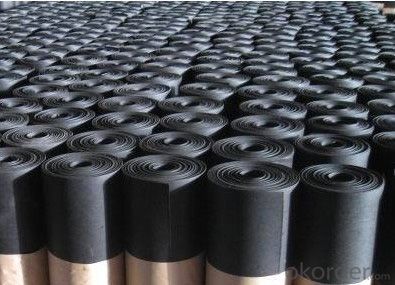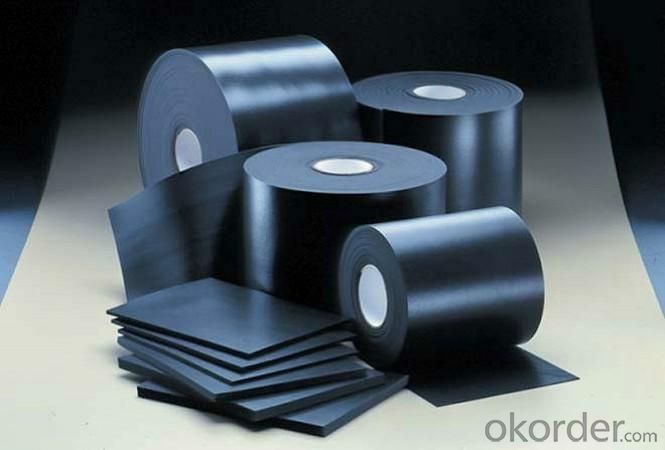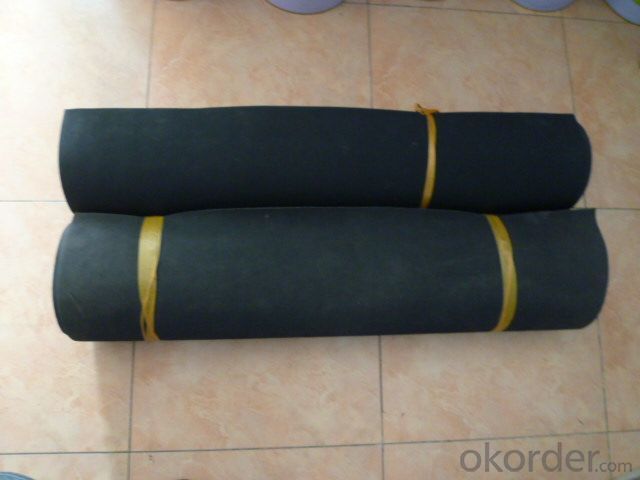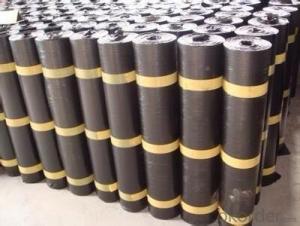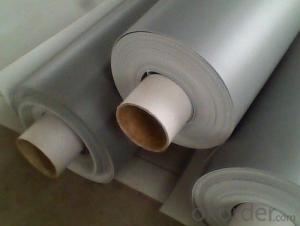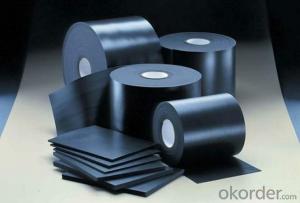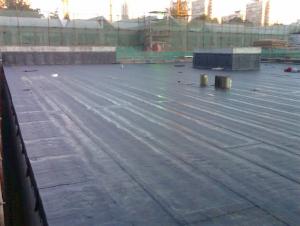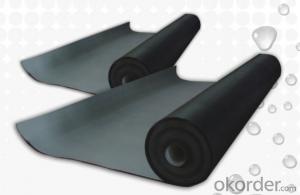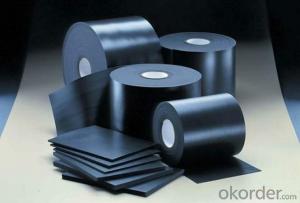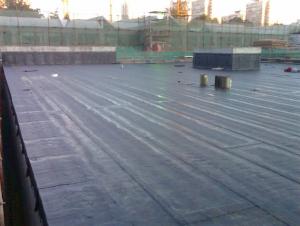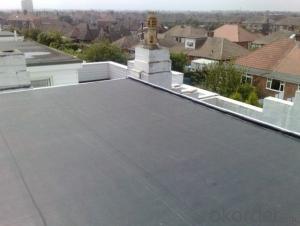EPDM Rubber Coiled Waterproof Membrane for Hotel Roof
- Loading Port:
- Shanghai
- Payment Terms:
- TT OR LC
- Min Order Qty:
- 50000 m²
- Supply Capability:
- 5000000 m²/month
OKorder Service Pledge
OKorder Financial Service
You Might Also Like
EPDM Rubber Coiled Waterproof Membrane for Hotel Roof
Description Of EPDM Rubber Coiled Waterproof Membrane for Hotel Roof:
•EPDM waterproof sheet has excellent anti-ozone-aging performance, able to resist ultraviolet light and corrosion of many chemical corrosive materials in the atmosphere
•It has high tensile strength, high ductility and strong retractility, it has excellent crack resistance, able to effect waterproof function even with tiny vibration of buildings.
• Excellent resistance to ozone, oxidation and sunlight.
• Resistance to chemicals; resistant to most inorganic products.
Main Features of EPDM Rubber Coiled Waterproof Membrane for Hotel Roof:
1>Excellent antiaging performance, service life up to 50 years
2>Working well with in 40C to 100C,it canbe constructed with a single layer in ambient temperature.
3>Waterproofing on various kinds of underground project,industrial of civil buildings and structures.
4>high extension rate, high tensile strength, small size changes at heat treatment
5>Good plant roots penetrability resistance and can be made waterproofing layer of planting roof
6>Special modified molecular structure ,effectively resolving the current domestic and foreign glue joint problem.
7>Good low temperature flexibility, and good performance of adapting to ambient temperature changes.
8>Convenient application ,solid joint, no environment pollution
9>chemical corrosion Resistance, can be used for special occasions
10>Convenient maitenance, low cost.
Specifications of EPDM Rubber Coiled Waterproof Membrane for Hotel Roof:
| Material | EPDM Rubber |
| Size | 1.2m (width)*20m (length) or customized, weldable type 2.05m or 4m width |
| Thick | 1.2mm, 1.5mm, 2.0mm |
| Type | Vulcanized & Weldable |
| Pattern | Non-reinforced (homogeneous) |
| Certificate | ISO9001/14001 |
Applications of EPDM Rubber Coiled Waterproof Membrane for Hotel Roof:
Widely used in roofs, basement, toilet ,swimming pool, and all kinds of industry and civil building waterproofing, reservoir, vivicism, bridge, underground, tunnel and dam waterproofing ,especially to the keystone waterproofing projects which is durability, high corrosion resistance and easy deformation.



IMages of EPDM Rubber Coiled Waterproof Membrane for Hotel Roof:




FAQ of EPDM Rubber Coiled Waterproof Membrane for Hotel Roof:
1. What are we supplying?
We are specialized in producing Colorful Asphalt Roof Shingle, SBS/APP modified bitumen waterproof membrane, Self adhesive bitumen waterproof membrane, PVC waterproofing membrane, EPDM rubber roofing membrane, Single Component Polyurethane Waterproof Coating, and Spray Polyurea Waterproof Coating
.
2. How Many years experience do we have?
We have been exported to more than 20 countries in the past 15 years.
3. How long do we usually reply your request?
We always reply our customer within 24 hours.
- Q: Are waterproofing membranes resistant to extreme weather conditions?
- Waterproofing membranes, indeed, possess the capacity to withstand even the most severe weather conditions. Typically composed of robust substances like rubber, PVC, or modified bitumen, these membranes can endure the detrimental impacts of harsh weather elements including heavy precipitation, snowfall, powerful gusts, and extreme temperatures. Their design incorporates flexibility and strength, guaranteeing their ability to effectively safeguard structures from water infiltration, even in the most challenging climatic circumstances. Furthermore, manufacturers often treat waterproofing membranes with UV stabilizers to counteract potential damage resulting from prolonged exposure to the sun's rays. In summary, these membranes offer reliable and long-lasting defense against extreme weather conditions.
- Q: Can a waterproofing membrane be used for stadiums or arenas?
- Certainly, stadiums and arenas can absolutely benefit from the utilization of waterproofing membranes. In fact, it is highly advisable to employ these membranes in these expansive constructions to shield them from water harm and leaks. These grand structures are frequently subjected to diverse weather conditions, including substantial rainfall and snowfall, which have the potential to infiltrate the edifice with water. A waterproofing membrane functions as a barricade, impeding water from entering the building and causing harm to its structural elements, such as concrete or steel. It aids in upholding the structure's integrity and protracting its lifespan. Moreover, waterproofing membranes also offer protection against other forms of moisture, such as condensation and humidity, which can result in mold growth and materials deterioration. Therefore, the application of a waterproofing membrane is an essential measure in guaranteeing the endurance and longevity of stadiums and arenas.
- Q: Can a waterproofing membrane be used on gypsum board surfaces?
- Yes, a waterproofing membrane can be used on gypsum board surfaces. This membrane helps to protect the gypsum board from moisture, preventing water damage and increasing its lifespan.
- Q: Can a waterproofing membrane protect against mold or mildew growth?
- Yes, a waterproofing membrane can help prevent mold or mildew growth by creating a barrier that keeps moisture out. By stopping water infiltration, it reduces the conditions necessary for mold and mildew to thrive, thus providing protection against their growth.
- Q: Can a waterproofing membrane be installed by a homeowner or is professional installation necessary?
- A waterproofing membrane can technically be installed by a homeowner, but it is highly recommended to have professional installation for optimal results. Waterproofing membranes are designed to protect buildings from water damage and require proper installation techniques and expertise to ensure their effectiveness. Professional installers have the knowledge and experience to properly assess the needs of the specific project, select the appropriate type of membrane, and install it correctly. They understand the best methods for surface preparation, membrane application, and seam sealing to create a watertight barrier. Additionally, professional installers have access to specialized equipment and tools that may be necessary for the installation process. They can also provide warranties or guarantees for their work, providing homeowners with peace of mind and protection in case any issues arise in the future. While it may seem possible for a homeowner to attempt the installation themselves, any mistakes or improper installation techniques could result in water leaks, mold growth, or other costly damages. It is always better to invest in professional installation to ensure that the waterproofing membrane functions as intended and provides long-term protection for the building.
- Q: Can a waterproofing membrane be used for a podium deck coating?
- Yes, a waterproofing membrane can be used for a podium deck coating. A waterproofing membrane is designed to create a barrier between the structure and the external environment, preventing water ingress and protecting the underlying surface. Podium decks, which are elevated platforms often found in commercial buildings or outdoor spaces, are susceptible to water damage due to exposure to weather elements. Applying a waterproofing membrane on the podium deck can effectively prevent water penetration and provide long-term protection against moisture-related issues such as leaks, mold, and deterioration. Additionally, some waterproofing membranes can also offer additional benefits such as UV resistance, crack bridging capabilities, and aesthetic enhancements. However, it is important to consider factors such as the specific requirements of the podium deck, the type of membrane being used, and the expertise of the applicator to ensure proper installation and compatibility with the deck substrate.
- Q: Can waterproofing membranes be used on swimming pool decks?
- Yes, waterproofing membranes can be used on swimming pool decks to protect them from water damage and leaks.
- Q: Can a waterproofing membrane be used for podium decks or plaza areas?
- Podium decks or plaza areas can benefit from the application of a waterproofing membrane. It is highly recommended to utilize this protective layer in order to safeguard the underlying structure from water-related harm. Given their exposure to the elements, podium decks and plaza areas are susceptible to water infiltration. By implementing a waterproofing membrane, water seepage into the lower layers can be effectively prevented, thus ensuring the long-lasting durability and structural integrity of the deck or plaza. Furthermore, this waterproofing membrane is also capable of shielding spaces beneath the deck or plaza, such as basements or parking garages, from potential water damage. Therefore, it is crucial to select a top-notch waterproofing membrane specifically designed for outdoor purposes, and to carefully adhere to the manufacturer's instructions regarding proper installation and maintenance.
- Q: Are waterproofing membranes resistant to saltwater corrosion?
- Yes, waterproofing membranes are generally resistant to saltwater corrosion. They are specifically designed to provide a protective barrier against water and moisture, including exposure to saltwater. These membranes are typically made from materials that resist corrosion, such as synthetic polymers or bitumen, which can withstand the corrosive effects of saltwater. Additionally, waterproofing membranes are often reinforced with additives or coatings that enhance their resistance to corrosion. However, it is important to note that the level of resistance may vary depending on the specific type and quality of the membrane used. It is advisable to consult with professionals or manufacturers to ensure that the chosen waterproofing membrane is suitable for saltwater environments.
- Q: Can a waterproofing membrane be used on precast concrete block surfaces?
- Precast concrete block surfaces can benefit from the application of a waterproofing membrane. These membranes are commonly used to safeguard below-grade structures, like basements and foundations, from water infiltration. When constructing these structures, precast concrete blocks are frequently utilized, and the use of a waterproofing membrane can prevent water from seeping into the concrete and causing harm. The membrane acts as a barrier, prohibiting water from passing through while still allowing the concrete to breathe and release any accumulated moisture. Furthermore, waterproofing membranes can enhance the overall durability and lifespan of precast concrete blocks by shielding them from moisture-related problems such as cracking, spalling, and corrosion. It is crucial to select a waterproofing membrane that is specifically designed for below-grade applications and is compatible with concrete surfaces to ensure proper adhesion and long-term efficacy.
Send your message to us
EPDM Rubber Coiled Waterproof Membrane for Hotel Roof
- Loading Port:
- Shanghai
- Payment Terms:
- TT OR LC
- Min Order Qty:
- 50000 m²
- Supply Capability:
- 5000000 m²/month
OKorder Service Pledge
OKorder Financial Service
Similar products
Hot products
Hot Searches
Related keywords
